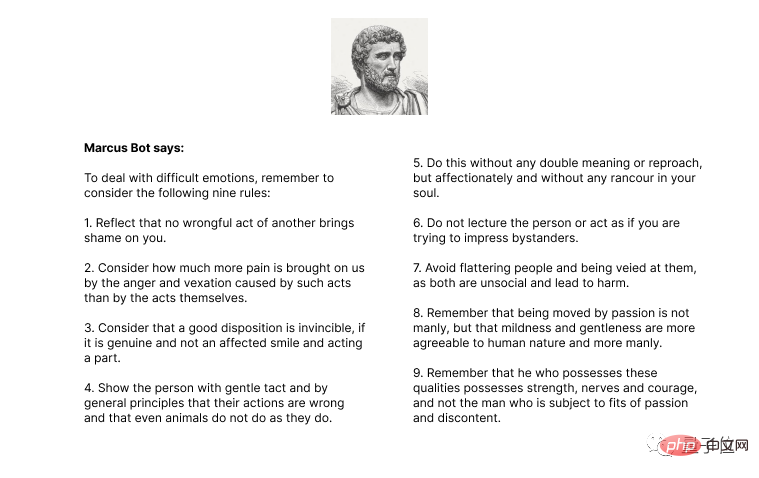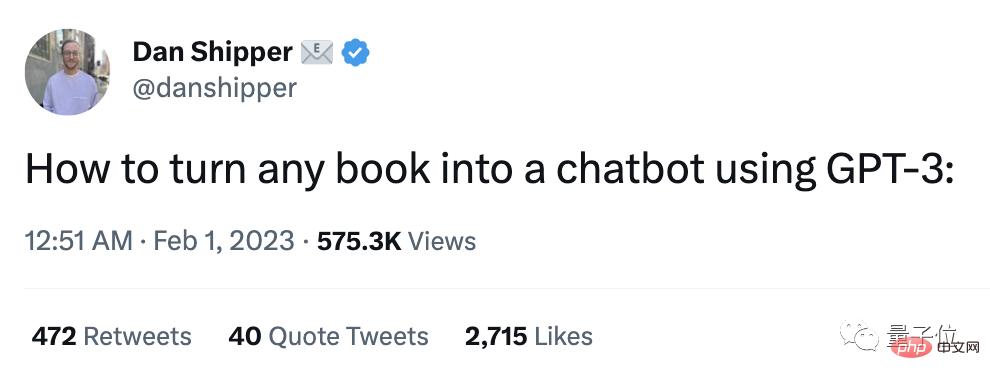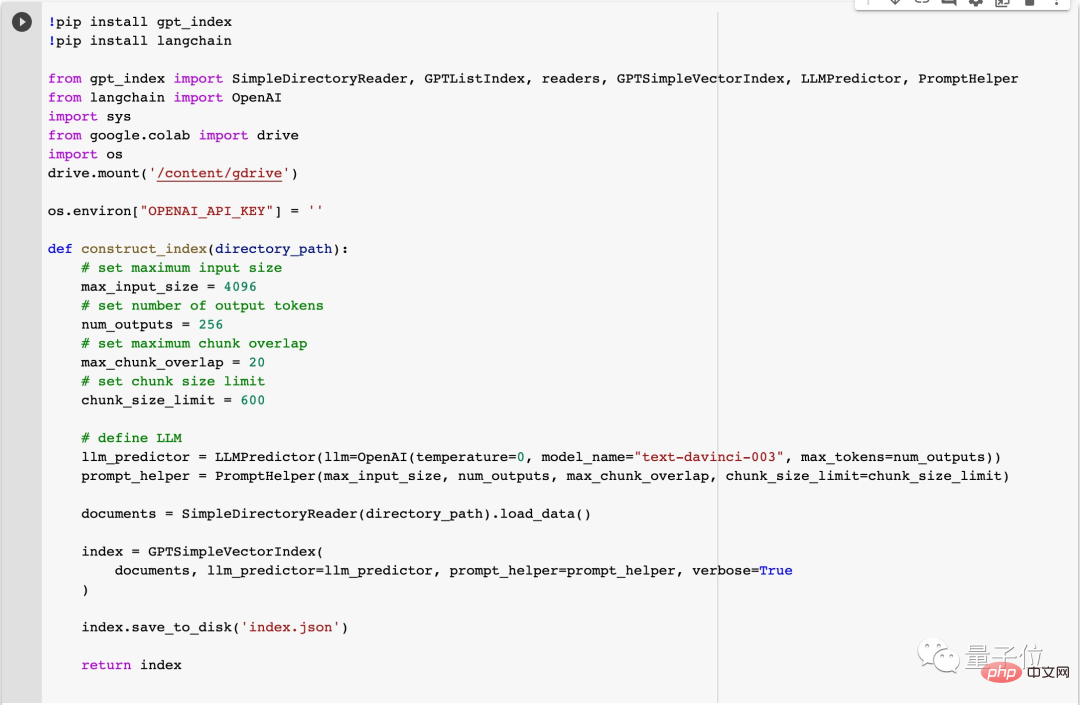He used GPT-3 to achieve 'quantum speed reading”
This article is reprinted with the authorization of AI New Media Qubit (public account ID: QbitAI). Please contact the source for reprinting.
Have you ever flipped through a book until you were bald just to check a question?
If only if there were contents in the book, Just ask and you would know...Wait, "You will know if you ask", how can this happenChatGPTThat smell?
By the way, someone actually developed a Chat Bot based on this idea. The book used as an example is Marcus Aurelius's "Meditations" (the book has 12 chapters in total) Volume, 497).
In just a few minutes, AI can memorize the entire book.
Then just ask about something mentioned in the book, such as "How to deal with negative emotions?" AI can quickly scan the text and give high-quality answers, and even list them for you one by one.

As soon as the original post was posted, netizens flocked to like it.

Developer Dan Shippers said that it is not difficult to make this AI. The main contributor is the large language model GPT-3, plus a few more lines The code is done.

In addition, this buddy even smelled a business opportunity:
There are many copyright-protected text, audio and video data sets on the Internet, which can Made into a chatbot!
For people who want to obtain information, sometimes they may give up when they see that they have to sort it out slowly after being paid; but if AI can quickly lock the target content, there should be more people Be willing to pay out of pocket.
How to make it?
In Brother Dan’s words, the Bot production process is mainly divided into 3 steps.
First, of course, is to find the materials for the whole life. For example, the entire "Meditations".
Brother Dan downloaded the original "Meditations" from the Internet and saved it in a folder on Google Dive. Through Google Drive, users can store files in the cloud, synchronize and share them between devices.
Then run the following Python code on Google's cloud programming platform Colab. You can not only access Google Drive, but also easily interact with GPT-3.

Dan introduced that GPT-3 can create a chat bot for you based on any text material.
But there is a problem: the number of text words that can be input to GPT-3 at a time is limited.
So The second step is to access the folder stored on Google Dive, and then divide the entire text material into small pieces and save them into new files.

The third step, when the user asks a question, first access the small pieces of content in the book that contain relevant explanations through OpenAI’s API, and then add these content Pass it to GPT-3 and sort out answers in fluent language.
The specific code is as follows:

At this point, the chat robot specially customized for the entire "Meditations" is ready.
In addition, based on this basic idea, Brother Dan also made a certain series of podcasts he liked into a chat bot.
He said that he once heard an interesting term on the show, but forgot what it meant. Usually if I want to understand it, I have to listen to an episode again.
But now there is a chatbot - hard of hearing? nonexistent.
Who is Dan?
Having said that, Dan’s past experience may also have had a certain impact on people being able to see new business opportunities through the chat machine.
He graduated from the liberal arts philosophy department of the University of Pennsylvania, but this guy is actually a technology tycoon.

He started programming in the 5th grade of elementary school. During college, he and his friends founded a software company, FireFly, with an income of more than six figures.
When he was still in his sophomore year, many technology companies had already offered him an olive branch, but they all rejected him, saying they wanted to complete his studies first.
As soon as he graduated from college, he sold FireFly to Pegasystems, a well-known business software company, and made his first pot of gold.
Immediately afterwards, he served as the project leader at Pega and increased the revenue of the business unit to the million-dollar level.
Later, he left Pega and founded a company Every in 2020, which mainly creates business briefings and podcasts. It currently has 60,000 subscribers.
(No wonder he would think of turning the podcast content into a chatbot
)
In addition to starting his own company, Dan also serves as the head of Sequoia Capital. Scout, advising venture capitalists.
The above is the detailed content of He used GPT-3 to achieve 'quantum speed reading”. For more information, please follow other related articles on the PHP Chinese website!

Hot AI Tools

Undresser.AI Undress
AI-powered app for creating realistic nude photos

AI Clothes Remover
Online AI tool for removing clothes from photos.

Undress AI Tool
Undress images for free

Clothoff.io
AI clothes remover

Video Face Swap
Swap faces in any video effortlessly with our completely free AI face swap tool!

Hot Article

Hot Tools

Notepad++7.3.1
Easy-to-use and free code editor

SublimeText3 Chinese version
Chinese version, very easy to use

Zend Studio 13.0.1
Powerful PHP integrated development environment

Dreamweaver CS6
Visual web development tools

SublimeText3 Mac version
God-level code editing software (SublimeText3)

Hot Topics
 1666
1666
 14
14
 1425
1425
 52
52
 1327
1327
 25
25
 1273
1273
 29
29
 1253
1253
 24
24
 How to use the chrono library in C?
Apr 28, 2025 pm 10:18 PM
How to use the chrono library in C?
Apr 28, 2025 pm 10:18 PM
Using the chrono library in C can allow you to control time and time intervals more accurately. Let's explore the charm of this library. C's chrono library is part of the standard library, which provides a modern way to deal with time and time intervals. For programmers who have suffered from time.h and ctime, chrono is undoubtedly a boon. It not only improves the readability and maintainability of the code, but also provides higher accuracy and flexibility. Let's start with the basics. The chrono library mainly includes the following key components: std::chrono::system_clock: represents the system clock, used to obtain the current time. std::chron
 How to understand DMA operations in C?
Apr 28, 2025 pm 10:09 PM
How to understand DMA operations in C?
Apr 28, 2025 pm 10:09 PM
DMA in C refers to DirectMemoryAccess, a direct memory access technology, allowing hardware devices to directly transmit data to memory without CPU intervention. 1) DMA operation is highly dependent on hardware devices and drivers, and the implementation method varies from system to system. 2) Direct access to memory may bring security risks, and the correctness and security of the code must be ensured. 3) DMA can improve performance, but improper use may lead to degradation of system performance. Through practice and learning, we can master the skills of using DMA and maximize its effectiveness in scenarios such as high-speed data transmission and real-time signal processing.
 How to handle high DPI display in C?
Apr 28, 2025 pm 09:57 PM
How to handle high DPI display in C?
Apr 28, 2025 pm 09:57 PM
Handling high DPI display in C can be achieved through the following steps: 1) Understand DPI and scaling, use the operating system API to obtain DPI information and adjust the graphics output; 2) Handle cross-platform compatibility, use cross-platform graphics libraries such as SDL or Qt; 3) Perform performance optimization, improve performance through cache, hardware acceleration, and dynamic adjustment of the details level; 4) Solve common problems, such as blurred text and interface elements are too small, and solve by correctly applying DPI scaling.
 What is real-time operating system programming in C?
Apr 28, 2025 pm 10:15 PM
What is real-time operating system programming in C?
Apr 28, 2025 pm 10:15 PM
C performs well in real-time operating system (RTOS) programming, providing efficient execution efficiency and precise time management. 1) C Meet the needs of RTOS through direct operation of hardware resources and efficient memory management. 2) Using object-oriented features, C can design a flexible task scheduling system. 3) C supports efficient interrupt processing, but dynamic memory allocation and exception processing must be avoided to ensure real-time. 4) Template programming and inline functions help in performance optimization. 5) In practical applications, C can be used to implement an efficient logging system.
 Steps to add and delete fields to MySQL tables
Apr 29, 2025 pm 04:15 PM
Steps to add and delete fields to MySQL tables
Apr 29, 2025 pm 04:15 PM
In MySQL, add fields using ALTERTABLEtable_nameADDCOLUMNnew_columnVARCHAR(255)AFTERexisting_column, delete fields using ALTERTABLEtable_nameDROPCOLUMNcolumn_to_drop. When adding fields, you need to specify a location to optimize query performance and data structure; before deleting fields, you need to confirm that the operation is irreversible; modifying table structure using online DDL, backup data, test environment, and low-load time periods is performance optimization and best practice.
 How to measure thread performance in C?
Apr 28, 2025 pm 10:21 PM
How to measure thread performance in C?
Apr 28, 2025 pm 10:21 PM
Measuring thread performance in C can use the timing tools, performance analysis tools, and custom timers in the standard library. 1. Use the library to measure execution time. 2. Use gprof for performance analysis. The steps include adding the -pg option during compilation, running the program to generate a gmon.out file, and generating a performance report. 3. Use Valgrind's Callgrind module to perform more detailed analysis. The steps include running the program to generate the callgrind.out file and viewing the results using kcachegrind. 4. Custom timers can flexibly measure the execution time of a specific code segment. These methods help to fully understand thread performance and optimize code.
 Quantitative Exchange Ranking 2025 Top 10 Recommendations for Digital Currency Quantitative Trading APPs
Apr 30, 2025 pm 07:24 PM
Quantitative Exchange Ranking 2025 Top 10 Recommendations for Digital Currency Quantitative Trading APPs
Apr 30, 2025 pm 07:24 PM
The built-in quantization tools on the exchange include: 1. Binance: Provides Binance Futures quantitative module, low handling fees, and supports AI-assisted transactions. 2. OKX (Ouyi): Supports multi-account management and intelligent order routing, and provides institutional-level risk control. The independent quantitative strategy platforms include: 3. 3Commas: drag-and-drop strategy generator, suitable for multi-platform hedging arbitrage. 4. Quadency: Professional-level algorithm strategy library, supporting customized risk thresholds. 5. Pionex: Built-in 16 preset strategy, low transaction fee. Vertical domain tools include: 6. Cryptohopper: cloud-based quantitative platform, supporting 150 technical indicators. 7. Bitsgap:
 How does deepseek official website achieve the effect of penetrating mouse scroll event?
Apr 30, 2025 pm 03:21 PM
How does deepseek official website achieve the effect of penetrating mouse scroll event?
Apr 30, 2025 pm 03:21 PM
How to achieve the effect of mouse scrolling event penetration? When we browse the web, we often encounter some special interaction designs. For example, on deepseek official website, �...




